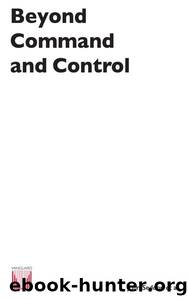Beyond Command and Control by John Seddon et al

Author:John Seddon et al [John Seddon et al]
Language: eng
Format: epub
ISBN: 9781527239562
Publisher: Mayfield Press
Published: 2019-12-15T00:00:00+00:00
Part 2:
Changing thinking about the management factory
7 The growth of management controls
In 1988 Peter Drucker wrote:
âThe typical large business 20 years hence will have fewer than half the levels of management of its counterpart today, and no more than a third the managersâ *
Peter Drucker should have been right. But he reckoned without the logic of command and control â thanks to which the opposite has happened. While many large service organisations have striven to flatten the hierarchy, this has not prevented the number of those employed in jobs sitting above the customer-facing front line from mushrooming. Almost all these jobs are concerned with control. HR, finance, audit, compliance, IT, performance management: all of these are control functions, on top of and as well as the management mechanisms we have discussed already. Going beyond command and control requires a re-think of what these functions are for and, more critically, a change in perspective in which hierarchical control gives way to enabling effective control; support rather than control.
In the early 1960s, the Tavistock Instituteâs Eric Trist made an important (and still neglected) discovery. Working with the then National Coal Board, he found that the much anticipated productivity gains from large-scale pit mechanisation were disappointing or even negative â except in one seam where workers had been allowed to develop their own cooperative way of working, with dramatically better results. From this emerged the idea of âsocio-technical systemsâ, which recognised that humans and machines, being interdependent, neither could be optimised at the expense of the other. However, despite the profound improvements in morale, attendance and productivity, Trist was dismayed when the board rejected his proposal to extend the new way of thinking more generally. The blunt reality was that, in an era of hostile management-union relations, managers simply could not accept the idea of the workers having control. In effect, they regarded control as more important than productivity. (To be fair, even the unions were opposed to workers being implicated in management).
In the years since then, countless programmes of empowerment, engagement, culture change and the like have attempted to involve workers in decision-making â and failed, since there was no diminution of the underlying management obsession with control. Given that we are all supposed to be knowledge workers now, one might hope that todayâs leaders would take a more constructive view of the potential for improving productivity through changing their theories of control, putting it in the hands of workers where the work is done.
Understanding what the hierarchical management functions do and how they impact on the system is not the jumping-off point for leaving command and control behind. That should always begin with operations. But the understanding is essential if leaders are to maintain the redesigned system.
We have come to think of the typical organisationâs superstructure of control as the âmanagement factoryâ. We coined this perhaps somewhat pejorative term in the 1990s when, observing a large blue-chip IT organisation, we were struck by the evident divide between operations and management, as though there were two systems, not one.
Download
This site does not store any files on its server. We only index and link to content provided by other sites. Please contact the content providers to delete copyright contents if any and email us, we'll remove relevant links or contents immediately.
Hit Refresh by Satya Nadella(9041)
The Compound Effect by Darren Hardy(8820)
Change Your Questions, Change Your Life by Marilee Adams(7640)
Nudge - Improving Decisions about Health, Wealth, and Happiness by Thaler Sunstein(7622)
The Black Swan by Nassim Nicholas Taleb(7016)
Deep Work by Cal Newport(6888)
Daring Greatly by Brene Brown(6451)
Rich Dad Poor Dad by Robert T. Kiyosaki(6414)
Principles: Life and Work by Ray Dalio(6227)
Playing to Win_ How Strategy Really Works by A.G. Lafley & Roger L. Martin(5938)
Man-made Catastrophes and Risk Information Concealment by Dmitry Chernov & Didier Sornette(5926)
Digital Minimalism by Cal Newport;(5669)
Big Magic: Creative Living Beyond Fear by Elizabeth Gilbert(5616)
The Myth of the Strong Leader by Archie Brown(5429)
The Slight Edge by Jeff Olson(5353)
Discipline Equals Freedom by Jocko Willink(5291)
The Motivation Myth by Jeff Haden(5158)
Stone's Rules by Roger Stone(5027)
The Laws of Human Nature by Robert Greene(5003)
